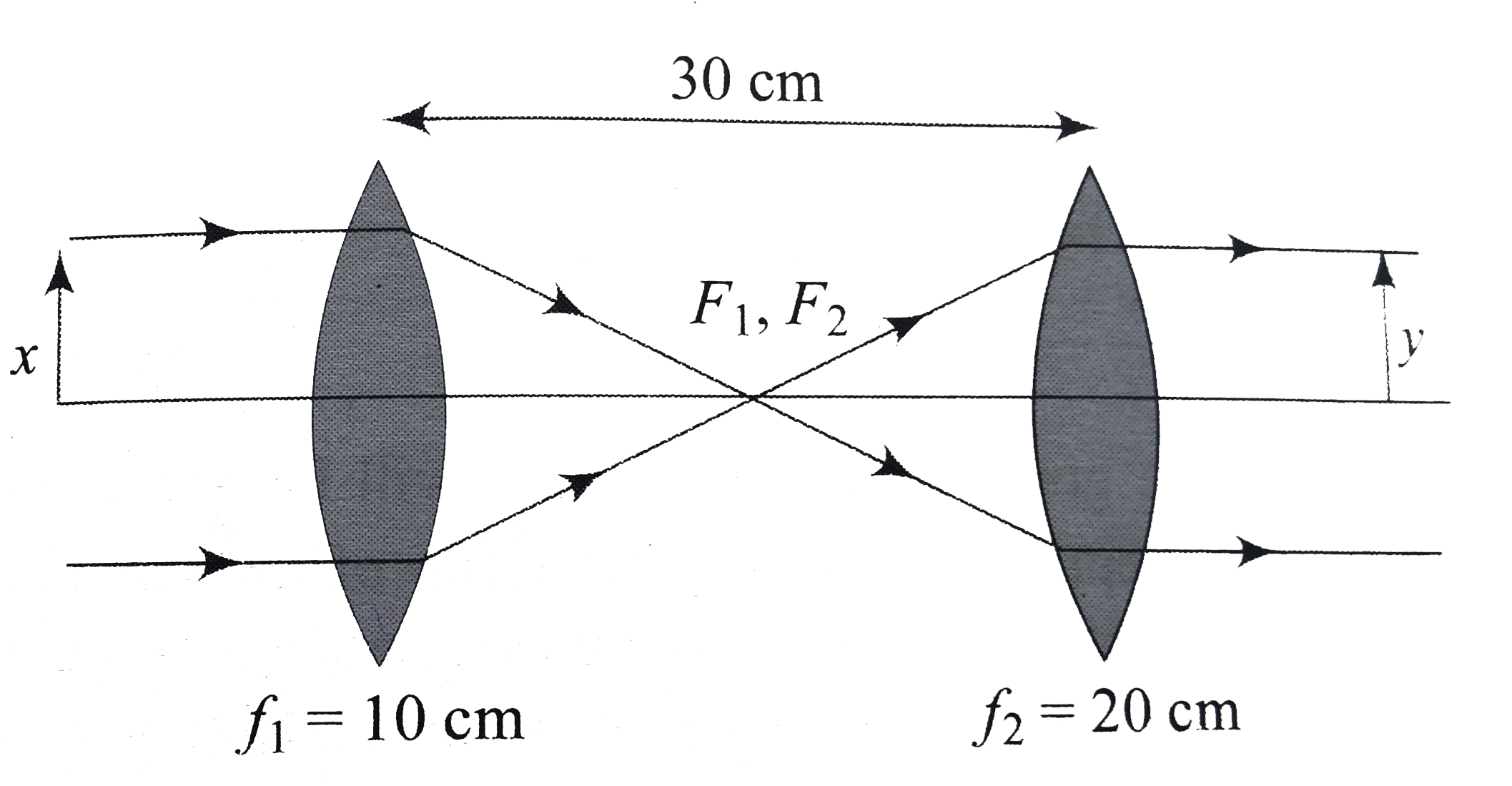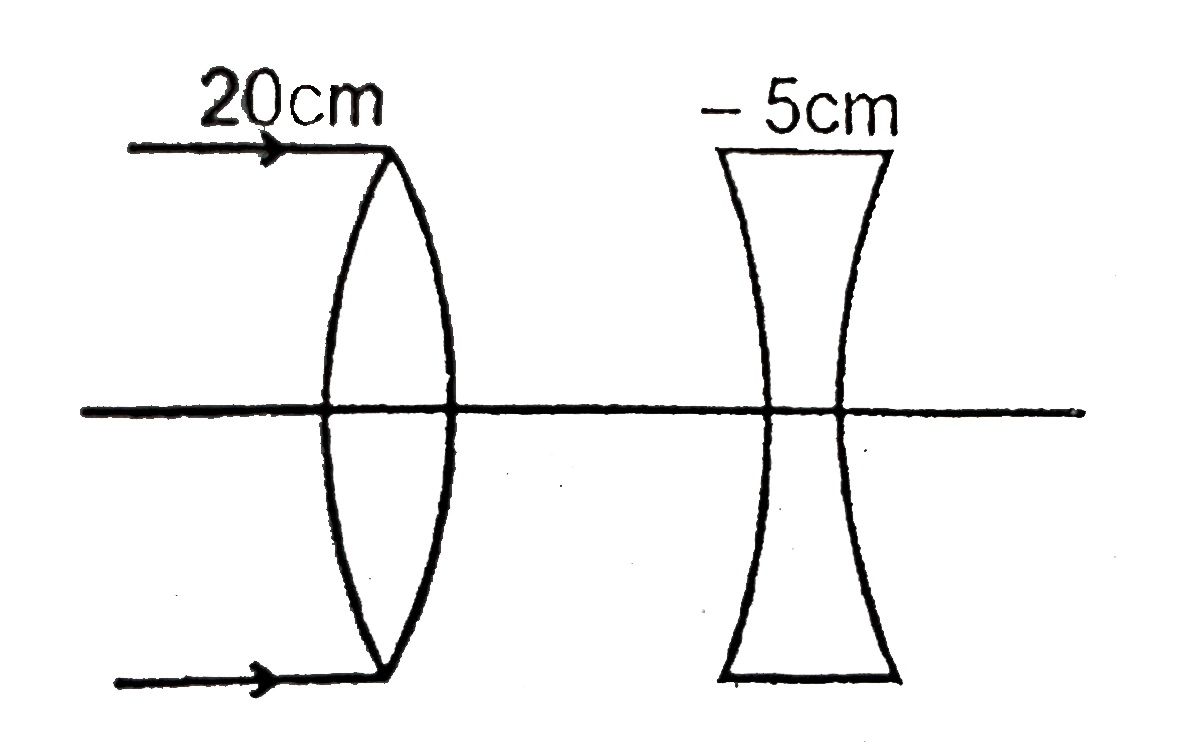Two converging lenses of focal lengths f1=10cm and f2=20cm are placed at some separation. A parallel beam of light is incident on first lens. Then,
for emergent beam form second lens to be parallel, the separation between the lenses has to be 30cm
for emergent beam from second lens to be parallel, the separation between the lenses has to be 60cm
if lenses are placed at such a separation that emergent beam from second lens is parallel, then the emergent beam width is 2cm if original beam has a width of 1cm
if lenses are placed at such a separation that emergent beam from second lens is parallel, then the emergent beam width is 4cm if original beam width is 1cm.
The correct Answer is:A, C
Here, x10=y20
y=2x
So, if x=1cm,y=2cm

Topper's Solved these Questions
- GEOMETRICAL OPTICSBOOK - CENGAGE PHYSICSCHAPTER - GEOMETRICAL OPTICSEXERCISE - Assertion-Reasoninig
2 Videos
- GEOMETRICAL OPTICSBOOK - CENGAGE PHYSICSCHAPTER - GEOMETRICAL OPTICSEXERCISE - Linked Comprehension
51 Videos
- GEOMETRICAL OPTICSBOOK - CENGAGE PHYSICSCHAPTER - GEOMETRICAL OPTICSEXERCISE - Subjective
26 Videos
- FRICTIONBOOK - CENGAGE PHYSICSCHAPTER - FRICTIONEXERCISE - QUESTION BANK
1 Video
- GRAVITATIONBOOK - CENGAGE PHYSICSCHAPTER - GRAVITATIONEXERCISE - Question Bank
39 Videos
Similar Questions
Consider a 'beam expander' which consists of two converging lenses of focal length 40 cm and 100 cm having a common optical axis. A laser beam of diameter 4 mm is incident on the 40 cm focal length lens. Then what is the diameter of the final beam (see figure)
_E01_142_Q01.png)
View SolutionTwo convex lenses, of focal lengths 20 cm and 10 cm, respectively are separated by a distance of x cm. If a parallel beam of light remain parallel after refraction through both the lenses find x.
View Solution
Knowledge Check
A convex lens of focal length 100 cm and a concave lens of focal length 10 cm are placed coaxialiy at a separation of 90 cm. If a parallel beam of light is incident on convex lens, then after passing through the two lenses the beam
AConvergesBDivergesCRemains parallelDDisappearsTwo thin lenses of focal lengths f1andf2 are placed in contact. The focal length of the composite lens will be
Af1+f22Bf1+f2f1f2C√f1f1Df1f2f1+f2A convex lens of focal length 20cm and a concave lens of focal length f are mounted coaxially 5cm apart. Parallel beam of light incident on the convex lens emerges from the concave lens as a parallel beam. Then, f in cm is
A35B25C20D15
A converging lens of focal length 20cm is separated 8 cm from a diverging lens of focal length 30 cm. A parallel beam of light falls on converging lens and after passing through diverging lens focussed at point P. Find the location of point P. Repeat the calculation for the case when the parallel beam first falls on diverging lens.
[4.2 cm from convex lens]
View SolutionTwo plano-convex lenses of focal lengths 20cm and 30cm are placed together to form a double convex lens. The final focal length will be
View SolutionTwo convex lenses of focal lengths f1andf2 are placed coaxially, a distance d apart. If the axis of one of the lenses is lifted parallel to itself by Δ, find the distance by which the focal point is shifted and the distance of the focal point from the first lens.
View SolutionIn the figure shown a converging lens and a diverging lens of focal lengths 20cm and -5cm respectively are separated by a distance such that a paralel beam of light of intensity 100 wa/m2 incident on the converging lens comes out as parallel beam from the diverging lens. Find the intensity of the outgoing beam in wa/m2

View SolutionTwo thin lenses of focal lengths 20cm and 25cm are placed in contact. The effective power of the combination is
View Solution